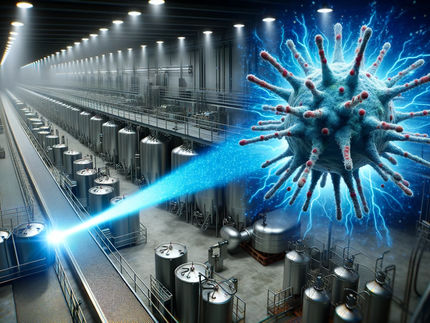Food safety: Biofilms improve the survival of listeria
listeriosis is a rare but dangerous bacterial disease. The cause of this disease is food contaminated by Listeria. Listeria is widespread and is also frequently found in food processing plants, where food can become contaminated. A recent study led by the Comet center FFoQSI (Austrian Competence Centre for Feed and Food Quality, Safety and Innovation; funded by BMK, BMDW and the federal states of Lower Austria, Upper Austria and Vienna) and the Vetmeduni now shows that Listeria (L.) monocytogenes can colonize existing biofilms. But not only that, L. monocytogenes also hides and survives in biofilms.

symbolic picture
computer generated picture
Microorganisms in the natural and man-made environment mainly live in communities that are protected by a self-produced matrix of extracellular polymeric substances (EPS). Within these so-called biofilms, microbial cells show altered phenotypes and gene expression patterns. In addition, the self-produced common matrix serves as a protective shield, nutrient source and provides space for genetic exchange.
Increased, long-term survivability in the hiding place of biofilms
L. monocytogenes can survive in the food production environment for a longer period of time. Here, biofilms may provide a niche for long-term survival as they protect against environmental fluctuations and disinfectants, as first author Eva Voglauer from FFoQSI (Austrian Competence Centre for Feed and Food Quality, Safety and Innovation) explains: "Our data suggest that L. monocytogenes can colonize multispecies biofilms, which could increase the ability to survive cleaning and disinfection in food processing plants and support persistence."
According to this, the bacterial composition and matrix composition of the biofilms is not significantly influenced by the presence of L. monocytogenes, meaning that Listeria hides unnoticed in the biofilm. According to study last author Kathrin Kober-Rychli (Center for Food Science and Public Veterinary Medicine/Vetmeduni), the gene expression study also showed "...that L. monocytogenes requires a specific set of genes to colonize biofilms."
Analysis of Listeria in a biofilm from a meat processing plant
For their study, the scientists investigated the behavior of an isolate of L. monocytogenes in a multispecies biofilm. This consisted of Pseudomonas fragi, Brochothrix thermosphacta and Carnobacterium maltaromaticum. These isolates were taken from a biofilm of a meat processing plant. The composition of the biofilm community and the matrix as well as the transcription activity were analyzed. "L. monocytogenes colonized the multispecies biofilm and accounted for 6.4 % of all biofilm cells after six hours. Transcriptomic analysis revealed that 127 genes of L. monocytogenes were significantly upregulated compared to the inoculum, including genes related to motility, chemotaxis, iron and protein transport," emphasize the study authors.
Listeriosis in humans and animals: Rare but dangerous disease
Listeria can also be found in refrigerated, vacuum-packed food - and can even multiply under these adverse conditions. This is due to two abilities that characterize listeria: On the one hand, they are cold-tolerant and, on the other, they can switch from an aerobic to an anaerobic state. In addition, Listeria are very resistant to acids and also insensitive to high salt concentrations. It is probably not least due to these properties that they can be found almost everywhere in nature. Due to high hygiene standards and the heating through of many products at risk, the number of cases of listeriosis is low. In Austria, 37 cases of invasive listeriosis in humans were reported by the National Reference Center (NRZ) in 2023.
These are severe cases that almost exclusively affect small children and people with weakened immune systems and can also lead to death. The pathogen is usually ingested through food. In addition to humans, other mammals are also affected, especially ruminants, but in rare cases also birds and even fish and crustaceans.
Note: This article has been translated using a computer system without human intervention. LUMITOS offers these automatic translations to present a wider range of current news. Since this article has been translated with automatic translation, it is possible that it contains errors in vocabulary, syntax or grammar. The original article in German can be found here.
Most read news
Topics
Organizations
Other news from the department science

Get the food & beverage industry in your inbox
By submitting this form you agree that LUMITOS AG will send you the newsletter(s) selected above by email. Your data will not be passed on to third parties. Your data will be stored and processed in accordance with our data protection regulations. LUMITOS may contact you by email for the purpose of advertising or market and opinion surveys. You can revoke your consent at any time without giving reasons to LUMITOS AG, Ernst-Augustin-Str. 2, 12489 Berlin, Germany or by e-mail at revoke@lumitos.com with effect for the future. In addition, each email contains a link to unsubscribe from the corresponding newsletter.




























































